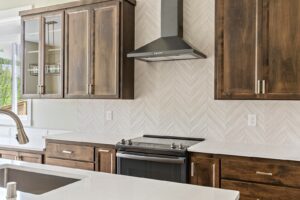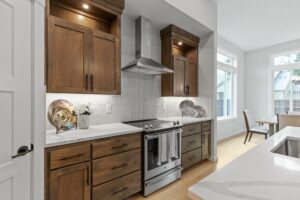A popular term in remodeling over the last few years, “aging in place” allows homeowners to update their homes to account for mobility challenges later in life. It’s easy to see why it has become so popular: instead of being moved to an adult care facility, homeowners are able to stay in their homes as they age. With Clark County being such a great place to live, more people are choosing this area as their destination for retirement. Retrofitting a home may not be feasible for empty nesters looking to either downsize or prepare for their golden years. For homes with more than one level and a flight of stairs or two, remodeling may not make much sense. Staircases that don’t lend themselves to lifts, or the impracticality of adding an elevator, can leave an entire floor unused.
These are just a few reasons why many homeowners are selling their empty nest and building a home to prepare for a changing lifestyle. This can be true for younger homeowners as well, if a sudden illness or injury facilitates the need for long-term wheelchair use. With advances in design and technology, and overall experience, building a home that is safe and functional for both physically healthy and physically challenged homeowners is becoming mainstream.
Bathroom
Making bathrooms easy to navigate should be one of the first priorities. Installing grab bars around the bathtub is a good start, but getting in and out of the bathtub can be an arduous process for someone with physical limitations. Consider a roll-in shower instead, complete with a bench, removable shower head, and grab bars. You can safely shower while seated and any tripping hazards are avoided by removing the lip at the bottom of the shower.

Consider a roll-in shower instead, complete with a bench, removable shower head, and grab bars.
Consider lowering the countertops in the bathroom as well and leave open space underneath the counter to make it easy for those in a wheelchair to pull into. Install drawers instead of lower cabinets so bathroom items are easy to retrieve. Many plumbing fixtures such as taller toilets (commonly called hi-boys) should be installed to allow for easier transfers from a wheelchair. Even something as simple as a toilet paper holder that can be changed with one hand can make life so much easier for those with arthritis.
These changes may seem a little premature for younger folks, but they can make all the difference should you develop physical limitations.
Kitchen
Along with the bathroom, kitchens present the most issues for those with mobility challenges. Many of the same bathroom design principles can also be applied here, including lower countertops, pull out drawers in the lower cabinets, and open spaces underneath the countertop to allow wheelchairs to roll up to work areas.

Open spaces underneath countertops will allow wheelchairs to roll up to work areas.
Newer appliances are being manufactured to be easier and safer for all users. Oven doors that open down make it difficult and dangerous to reach inside, so they’re being replaced by doors that open to the side, making it easier and safer to work with. Also consider raising the height of the dishwasher to lessen the need to bend over, lowering the cooktop, installing a refrigerator with increased storage on the doors and freezers on the bottom or side by side. All should have easy to use panels with large buttons and easy to read displays.
Pull-down upper cabinets also make storage more accessible from a seated position, and all cabinets should have handles that are easy to use. Smaller knobs are sometimes difficult for arthritic hands to grasp. Enough room to move around with a walker or a wheelchair is a must, so kitchen spaces are designed with wider travel paths.
Around the house
So many items in our homes are built to standard specifications, such as light switches, outlets, and even the width of doors or hallways. Even a throw rug can be a tripping hazard for someone using a walker or other assistance device. By lowering the light switches, raising the outlets, and installing wide doors, life becomes easier for those using a walker or wheelchair.
New technology can greatly improve home safety. Video doorbells allow homeowners to safely see and even talk to visitors without having to open the door. Lights can be voice-activated to eliminate fumbling about in the dark. Smartphones with alarms and reminders can help keep track of medications or alert emergency personnel in case of an accident. Personal assistants such as Google Home and Amazon’s Alexa can assist with reminders, turning on lights and appliances, and even entertain by answering questions, playing music and telling stories.
Every aspect of home design should be considered when planning for aging in place.
Contact Evergreen Homes for more design ideas about aging in place and the steps you can take to make your next house a true forever home.



